Improved Spectrum Sensing Technique in Cognitive Radio for 5G Massive System
Keywords:
BER, Cognitive Radio, Compressive Sensing, MIMO-OFDMAbstract
Error free transmission and increase in multimedia applications is one of the main aims of wireless communication. MIMO-OFDM is the system to improve the reliability of the WiMAX system. The fundamental tasks that are used in the Cognitive Radio (CR) networks are spectrum shaping capability and multi carrier systems. In these structures activation of fundamental (primary) users will generate a defined number of sub carriers in the secondary users. In this paper, the design of Multiple Input Multiple Output Orthogonal Frequency Division Multiplexing (MIMO-OFDM) system using compressive Sensing Cognitive Radio Network is presented. A compressive is a spectrum-sensing method that detects the free portions of the primary user’s spectrum and allocates it to secondary users. It derives from cross-correlating an unknown signal with known ones to detect the unknown signal’s presence based on the basis of its Signal to Noise Ratio (SNR). Accordingly, an efficient scheme is developed here that is having better SNR vs Bit Error Rate (BER) against a different MIMO-OFDM system.
References
Lovely Rajput, S. R. Mansore, Girish Kumar Tiwari, “Spectrum Sensing in Cognitive Radio Network for 5G Technology”, International Journal of Research and Technology, Volume 9, Issue 2, June 2021.
Sudhanshu Joshi, Prof. Shivendra Singh and Dr. Rajesh Nema, “Performance Analysis of Cognitive Networks Based on Multi-Band Spectrum Sensing for IOT”, Second International Conference on Smart Systems and Inventive Technology, IEEE 2019.
Teethiya Datta, Shohely Tasnim Anindo and Sk. Shariful Alam, “Detection Performance Analysis of Compressive Sensing in Cooperative Cognitive Radio Network”, 1st International Conference on Advances in Science, Engineering and Robotics Technology 2019.
Shruti Bhandari, Mehul Bhandari and Sunil Joshi, “Spectrum Sharing in Cognitive Radio Networks for 5G Vision”, Second International Conference on Advanced Computational and Communication Paradigms, IEEE 2019.
S. Bhandari, S. Joshi, Cognitive Radio Technology in 5G Wireless Communications, In Proc. 2nd IEEE International conference on Power Electronics, Intelligent Control and Energy systems (ICPEICES-2018), Oct 2018.
Rubayet Shafin, Lingjia Liu, Jonathan Ashdown, John Matyjas and Jianzhong Zhang; On the Channel Estimation of Multi-cell Massive FD-MIMO Systems; IEEE International Conference on Communication (ICC), IEEE, 2018.
G. Shine Let, G. Josemin Bala, J. Jenkin Winston, M. Deepak Raj and C. Benin Pratap; Prominence of Cooperative Communication in 5G Cognitive Radio Systems; International Conference on circuits Power and Computing Technologies (ICCPCT), IEEE, 2017.
Akhilesh Venkatasubramanian, Krithika. V and Paritbane. B; Channel Estimation for A Multi-User MIMOOFDM- IDMA System; International Conference on Communication and Signal Processing, IEEE, 2017.
Samira Boualleg, Khalida Ghanem, Brahim Haraoubia, and Mourad Nedil; On the Performance Enhancement when combining STBC and Channel Estimation Techniques in Underground MIMO Channels; IEEE Communication Letters, Vol. 15. No. 07. pp. 394-397. IEEE, 2016.
Mel Li, Xiang Wang and Kun Zhang; Comparative Study of Adaptive Filter Channel Estimation Technique in MIMO-OFDM System Based on STBC; International Conference on Machine Learning and Cybernetics, Lanzhou, pp. 13-16. IEEE, 2014.
Biswajit Sahoo, Ravi Ranjan Prasad, and P. Samundiswary; BER Analysis of Mobile WiMAX System using LDPC Coding and MIMO System under Rayleigh Channel; International conference on Communication and Signal Processing, pp. 01-06. IEEE, 2013.
Muhammet Nuri Seyman, Necmi Taspınar; Channel estimation based on neural network in space time block coded MIMO-OFDM system; Digital Signal Processing, Vol. 23. No.1. pp. 275-280, IEEE 2013.
Yuan Jinsha, and Shi Hongmei; A Modified Symbol Timing Synchronization Algorithm for WiMAX OFDM Systems; Pacific-Asia Workshop on Computational Intelligence and Industrial Application, pp. 748-751. IEEE, 2012.
Downloads
How to Cite
Issue
Section
License

This work is licensed under a Creative Commons Attribution-NonCommercial 4.0 International License.





